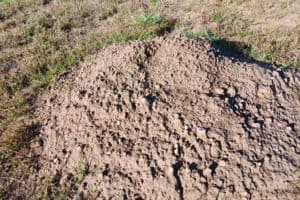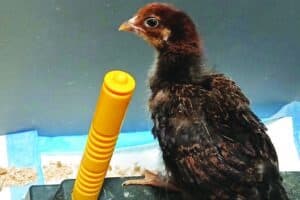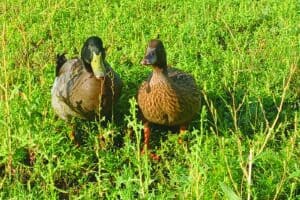Longtime local journalist Bill Radford and his wife, Margaret, live on 5 acres in the Falcon area with ducks, chickens, rabbits, dogs, cats, two noisy parrots, goats and two horses. Contact Bill at billradford3@gmail.com.
It was during the morning feeding of the horses that Margaret heard coughing coming from the goats’ stall.Peeking over the stall front, she saw Chica the goat in dire straits; she had gotten her head caught in a hay net and was writhing and choking.Margaret struggled to get Chica loose, but she was too wound up in the net. So Margaret grabbed a knife and cut open the hay net. Chica was freed.We had tried the hay net as a way to cut down on waste. We might not have done so if we had spotted warnings such as this one at thegoatspot.net: “Hay nets are very dangerous, they get their heads and legs tangled in them, they can strangle themselves and break limbs.”Others online note success with their hay nets; one piece of advice is to hang the net high enough that the goats have to work to reach it and can’t get caught in it. But for us, it was a close call ñ- one that brought to mind other near animal disasters. There was the time, for example, when I found a trapped Molly the mule: Somehow she had gotten a leg stuck in a horse fence panel while her head was lodged above the top of the panel, and she could barely breathe.I pushed her leg in away from the panel as hard as I could while our neighbor Shirley lifted her head, and we were able to free her. But, again, it could have ended tragically.If you Google animals and injuries, you’ll find a lot of information on injuries CAUSED by animals and little on injuries TO animals. (By the way, if you hang around cows, be careful: Cattle account for more fatal work injuries than any other animal, according to a Bureau of Labor Statistics study. Equines, including horses, mules and donkeys, come in at No. 2.)But as any animal lover knows, pets ñ- from tiny kittens to 1,000-pound horses ó can get into all kinds of predicaments. And wind up getting hurt in the process.Animals can be unpredictable,” Farmanddairy.com warns. “No matter how well you think you know your livestock, something could spook them, causing the animal to react quickly and violently. A majority of the time, human error is to blame for accidents with livestock ó a lapse in judgment, inexperience or unpreparedness.îHuman error ó our error ó was to blame when our goat Christmas got her head stuck in the fence years ago; that’s because we had used livestock panels intended for cows instead of panels with smaller holes that a goat couldn’t get its head through. Luckily, Christmas wasn’t hurt. I also blame myself for Honey the duck getting an infection known as bumblefoot; I had left a board with nails sticking up that she had apparently stepped on.So, if you have a menagerie full of animals big or small, take steps to keep them safe ó not just from predators, but also from hazards. Look for loose fencing, hidden holes, tripping hazards and sharp edges.When handling livestock, the National Ag Safety Database (nasdonline.org) offers these tips:
- Most animals will respond to routine; be calm and deliberate.
- Announce your presence well in advance of getting close to an animal, to avoid startling it.
- Avoid quick movements or loud noises.
- Be patient; never prod an animal when it has nowhere to go.
- Respect livestock ó don’t fear it!
- Move slowly and deliberately around livestock; gently touch animals rather than shoving or bumping them.
- Always provide yourself with an escape route when working with an animal in close quarters.






